
An out-of-place artifact is an artifact of historical, archaeological, or paleontological interest found in an unusual context, which challenges conventional historical chronology by its presence in that context. Such artifacts may appear too advanced for the technology known to have existed at the time, or may suggest human presence at a time before humans are known to have existed. Other examples may suggest contact between different cultures that is hard to account for with conventional historical understanding.

Ouray is a home rule municipality that is the county seat of Ouray County, Colorado, United States. The city population was 1,000 as of the 2010 census. The Ouray Post Office has the ZIP Code 81427. Ouray's climate, natural alpine environment, and scenery have earned it the nickname "Switzerland of America".

The Town of Ridgway is the home rule municipality that is the most populous municipality in Ouray County, Colorado, United States. The town is a former railroad stop on the Uncompahgre River in the northern San Juan Mountains. The town population was 713 at the 2000 census and 924 according to the 2010 census.

Petrified Forest National Park is an American national park in Navajo and Apache counties in northeastern Arizona. Named for its large deposits of petrified wood, the park covers about 346 square miles, encompassing semi-desert shrub steppe as well as highly eroded and colorful badlands. The park's headquarters is about 26 miles (42 km) east of Holbrook along Interstate 40 (I-40), which parallels the BNSF Railway's Southern Transcon, the Puerco River, and historic U.S. Route 66, all crossing the park roughly east–west. The site, the northern part of which extends into the Painted Desert, was declared a national monument in 1906 and a national park in 1962. The park received 644,922 recreational visitors in 2018.

The Cardiff Giant was one of the most famous archaeological hoaxes in American history. It was a 10-foot-tall (3.0 m), 3,000 pound purported "petrified man" uncovered on October 16, 1869, by workers digging a well behind the barn of William C. "Stub" Newell in Cardiff, New York. He covered the giant with a tent and it soon became an attraction site. Both it and an unauthorized copy made by P. T. Barnum are still being displayed. The original is currently on display at The Farmers' Museum in Cooperstown, New York. The copied one is on display at The Fort Museum & Frontier Village in Fort Dodge, Iowa.

Ouray was a Native American chief of the Tabeguache (Uncompahgre) band of the Ute tribe, then located in western Colorado. Because of his leadership ability, Ouray was acknowledged by the United States government as a chief of the Ute and he traveled to Washington, D.C. to negotiate for the welfare of the Utes. Raised in the culturally diverse town of Taos, Ouray learned to speak many languages that helped him in the negotiations, which were complicated by the manipulation of his grief over his five-year-old son abducted during attack by the Sioux and trantee. Ouray met with Presidents Lincoln, Grant, and Hayes and was called the man of peace because he sought to make treaties with settlers and the government.
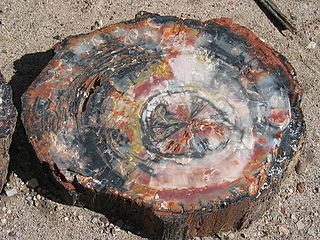
In geology, petrifaction or petrification is the process by which organic material becomes a fossil through the replacement of the original material and the filling of the original pore spaces with minerals. Petrified wood typifies this process, but all organisms, from bacteria to vertebrates, can become petrified. Petrifaction takes place through a combination of two similar processes: permineralization and replacement. These processes create replicas of the original specimen that are similar down to the microscopic level.

Edward Prentiss Costigan was a Democratic Party politician who represented Colorado in the United States Senate from 1931 to 1937. He was a founding member of the Progressive Party in Colorado in 1912.

William A. Muldoon was the Greco-Roman Wrestling Champion, a physical culturist and the first chairman of the New York State Athletic Commission. He once wrestled a match that lasted over seven hours. Nicknamed "The Solid Man," Muldoon established himself as champion in Greco-Roman wrestling in the 1880s and over the years gained a remarkable measure of public influence that would continue through his days as a health farm proprietor in Westchester County and his service on NYSAC. Muldoon was a mainstay in New York sports for over 50 years.
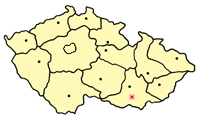
Dolní Věstonice is an Upper Paleolithic archaeological site near the village of Dolní Věstonice in the South Moravian Region of the Czech Republic, on the base of Děvín Mountain 550 metres (1,800 ft). It dates to approximately 26,000 BP, as supported by radiocarbon dating. The site is unique in that it has been a particularly abundant source of prehistoric artifacts dating from the Gravettian period, which spanned roughly from 27,000 to 20,000 BC. In addition to the abundance of art, this site also includes carved representations of men, women, and animals, along with personal ornaments, human burials and enigmatic engravings.
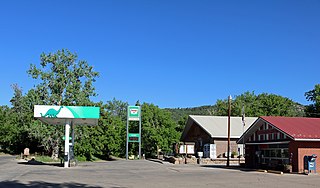
Beulah is an unincorporated community and a post office located within the Beulah Valley census-designated place in Pueblo County, Colorado, United States. The Beulah Post Office has the ZIP code 81023. Beulah is a part of the Beulah Valley CDP. Beulah lies along State Highway 78 about 21 miles southwest of Pueblo, in the foothills of the Wet Mountains.

The following outline is provided as an overview of and topical guide to the U.S. state of Colorado:
Prehistory of Colorado provides an overview of the activities that occurred prior to Colorado's recorded history. Colorado experienced cataclysmic geological events over billions of years, which shaped the land and resulted in diverse ecosystems. The ecosystems included several ice ages, tropical oceans, and a massive volcanic eruption. Then, ancient layers of earth rose to become the Rocky Mountains.

The Pueblo IV Period was the fourth period of ancient pueblo life in the American Southwest. At the end of prior Pueblo III Period, Ancestral Puebloans living in the Colorado and Utah regions abandoned their settlements and migrated south to the Pecos River and Rio Grande valleys. As a result, pueblos in those areas saw a significant increase in total population.
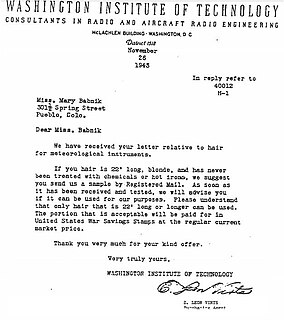
Mary Babnik Brown was an American who became known for having donated her hair to the United States military during World War II. Thirty-four inches (86 cm) long, her blonde hair had never been chemically treated or heated with curling irons.

The choice of the permanent capital of the U.S. state of Colorado was put to a popular vote in 1881. The cities in active contention were: Denver, Del Norte, Pueblo, Colorado Springs, Canon City, and Salida. The City of Denver, which had been the temporary capital since Colorado became a state in 1876, was chosen by 66 percent of voters.

Wilbur F. Stone Sr. was a teacher, lawyer, newspaper editor, miner, elected official, historian, and associate justice of the Colorado Supreme Court. He compiled the four volume A History of Colorado.

Guston is a silver mining ghost town in Ouray County, Colorado, United States, 11 miles (18 km) south of Ouray following the "Million Dollar Highway". Nestled in Champion Gulch, it is located near Red Mountain and the remnants of Red Mountain Town and Ironton. The Silverton Railroad ran from Guston in the Red Mountain Pass to Silverton in San Juan County.

Otto Bulow was an architect from Sweden who worked in Pueblo, Colorado. He designed the Colorado Mineral Palace.
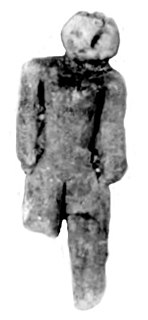
The Nampa figurine is a 1.5 inches (38 mm) fired clay doll found near Nampa, Idaho in 1889. The figurine has been dyed red, possibly due to iron oxide deposition, and depicts a female figure with jewelry and clothing. The artifact has been the subject of substantial controversy over its apparent age. The initial estimates of the artifact placed its age at 2 million years old, significantly outdating any other clay artifacts and humanity's arrival in the Americas.



















